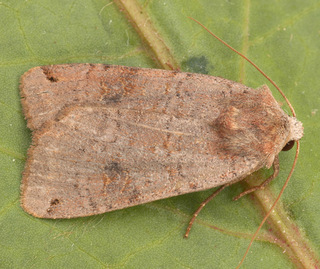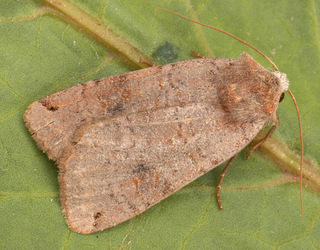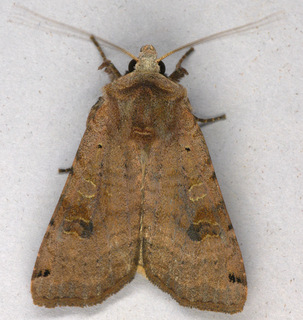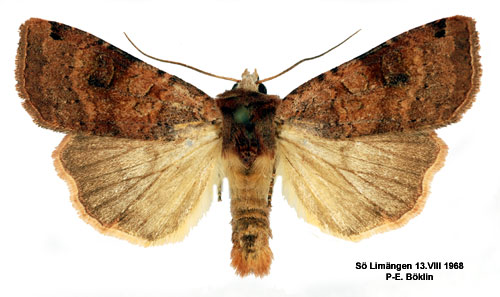Xestia baja
Xestia baja
The Baja Bodeneule ( Xestia baja ), also known as Black Dotted Erdeule, is a butterfly (moth ) from the family of cutworms ( Noctuidae ).
- 6.1 Notes and references
- 6.2 Literature
Features
Butterfly
The moths reach a wingspan of 38-44 millimeters (35 to 40 mm). The ground color of the forewings normally varies from reddish brown, light gray-brown to ocher. Extreme color variations can also light yellow -gray to light yellow brown in color (formative grisea Tutt ) or even a slight bluish or purple sheen have (form coerulescens Tutt ). Transverse and wavy lines are indicated often indistinct or only slightly. They are, if they are developed, finely serrated. In contrast, the brokering are usually well developed. Both stigma often have a thin white border, rarely also a darker border. The lower part of the renal defect is filled sometimes blackish. There is a darker shade means intermediate ring and kidney blemish. Rarely occurs a Zapfelmakel, which may be drawn significantly especially in the distal region. There, where the wavy line meets at the front edge, there is a characteristic deep black, elongated stains which can sometimes be formed as a colon. The undersides are pollinated reddish. The hind wings are without markings, however, dark gray, the fringe reddish shimmer.
Egg, caterpillar, pupa
The egg has a spherical shape with a flattened base and numerous fine ribs. It is first dyed pure white and takes just before hatching, the young caterpillar on a dark purple tint.
Adults caterpillars vary greatly in color and can yellow gray, brown or reddish specimens produce. You have a clumsy shape, fine, yellow-white back and side back lines and numerous dark brown angular spots that are more prominent at the back.
The red-brown doll has two spines on the cremaster.
Differences
The typical feature of the species is a deep black spot at the point where the often completely verloschene wave line meets the front edge of the forewing; it can sometimes be formed as a colon.
Geographical distribution and habitat
The species occurs throughout Europe prior to the Arctic Circle and is missing only on the islands of the Mediterranean, in southern Spain, southern Italy and southern Greece. Further east, it is through the temperate zone to East Asia ( Russian Far East, Japan, Korea and North China), including areas of Tibet and Mongolia common. In Asia, the Nominatunterart of the ssp. bajula replaced. In the Alps, the nominate rises to a height of about 1800 meters.
The Baja Bodeneule inhabited preferably deciduous, mixed and coniferous forests, shrub and bush zones, slopes, wetlands and parklands.
Way of life
The Baja Bodeneule is univoltine, that is, it forms only one generation per year. Main flight time of nocturnal moths are the months of July to September. In warm years, the moths can even slip the end of June. Visit artificial light sources as well as the bait, occasionally the flowers of pipes grasses ( Molinia ), Greis herbs ( Senecio ), the dwarf elder (Sambucus ebulus ) or the butterfly lilac ( Budleja davidii ). On the day the moths resting on the ground or in the herb layer, occasionally they also sit on tree trunks, fences or cabin walls. The also nocturnal caterpillars are found from August; on the day they rest on the ground or in ground-level vegetation. They feed on various plants, these include:
- Purple moor grass ( Molinia caerulea),
- Hazel (Corylus avellana )
- Blackthorn (Prunus spinosa),
- White bedstraw ( Galium album )
- Meadow Sage (Salvia pratensis)
- Bilberry (Vaccinium myrtillus ) and
- Raspberry (Rubus idaeus ).
Ian Kimber mentioned:
- Bog myrtle ( Myrica gale )
- Rubus sp.
Bergmann reported that the "small" caterpillars overwinter; However, even L4- caterpillars have been documented in October. They complete their development in the spring of the following year and pupate in May in a burrow or Erdkokon.
Endangering
The Baja Bodeneule comes in Germany spread ago, is regionally to meet many and is carried on the Red List of Threatened Species as not at risk.
Taxonomy and systematics
The species was described under the name Noctua baja 1775 by Michael Denis Johann Ignaz and Schiffermueller first time. Due to a certain color variability infrasubspecific numerous taxa ( formae ) have been established. The established after 1930 formae are not available under the rules of international zoological nomenclature and can only be used informally. The species is currently divided into two subspecies:
- Xestia baja baja Denis & Schiffer Müller, 1775, Europe, West Asia
- Xestia baja bajula Staudinger, 1881, Central Asia and Far East







.jpg)


